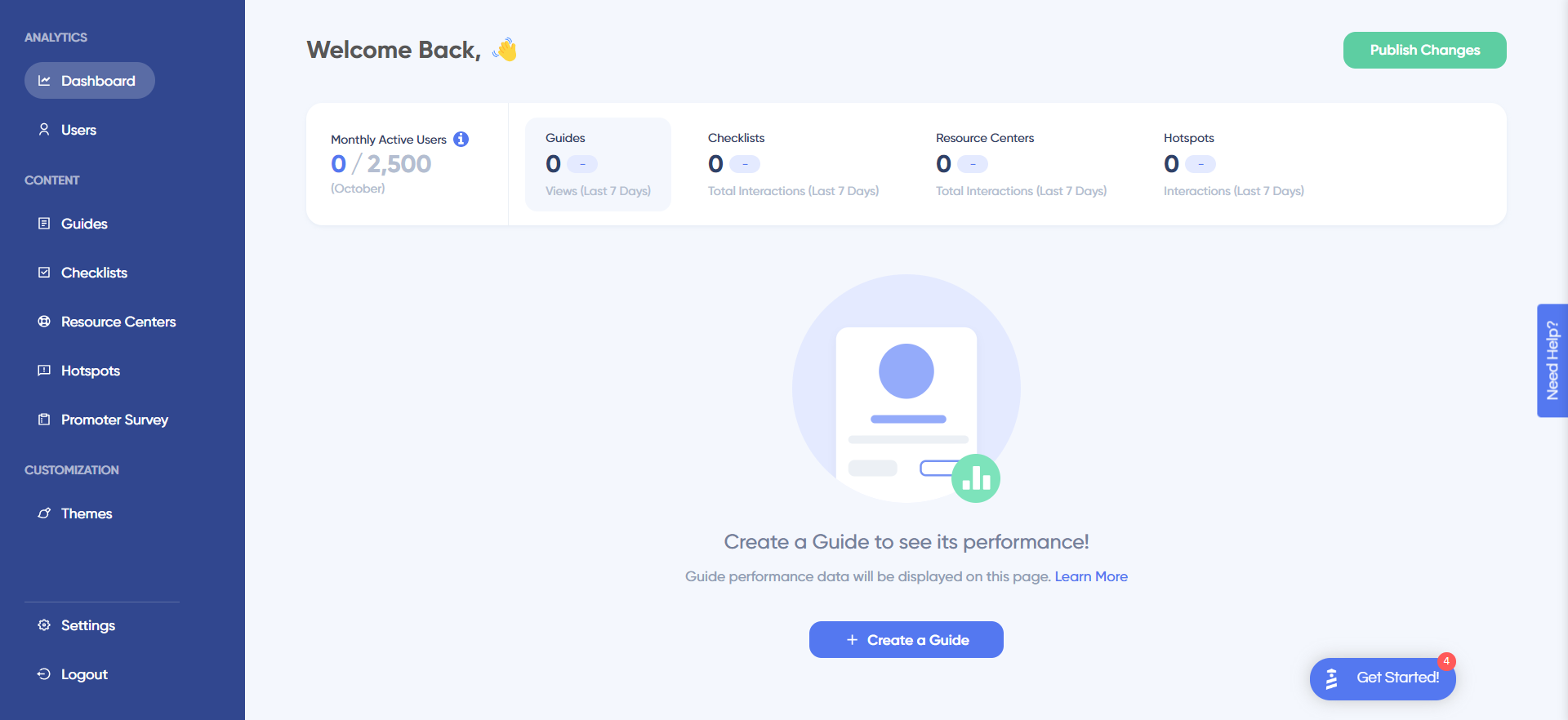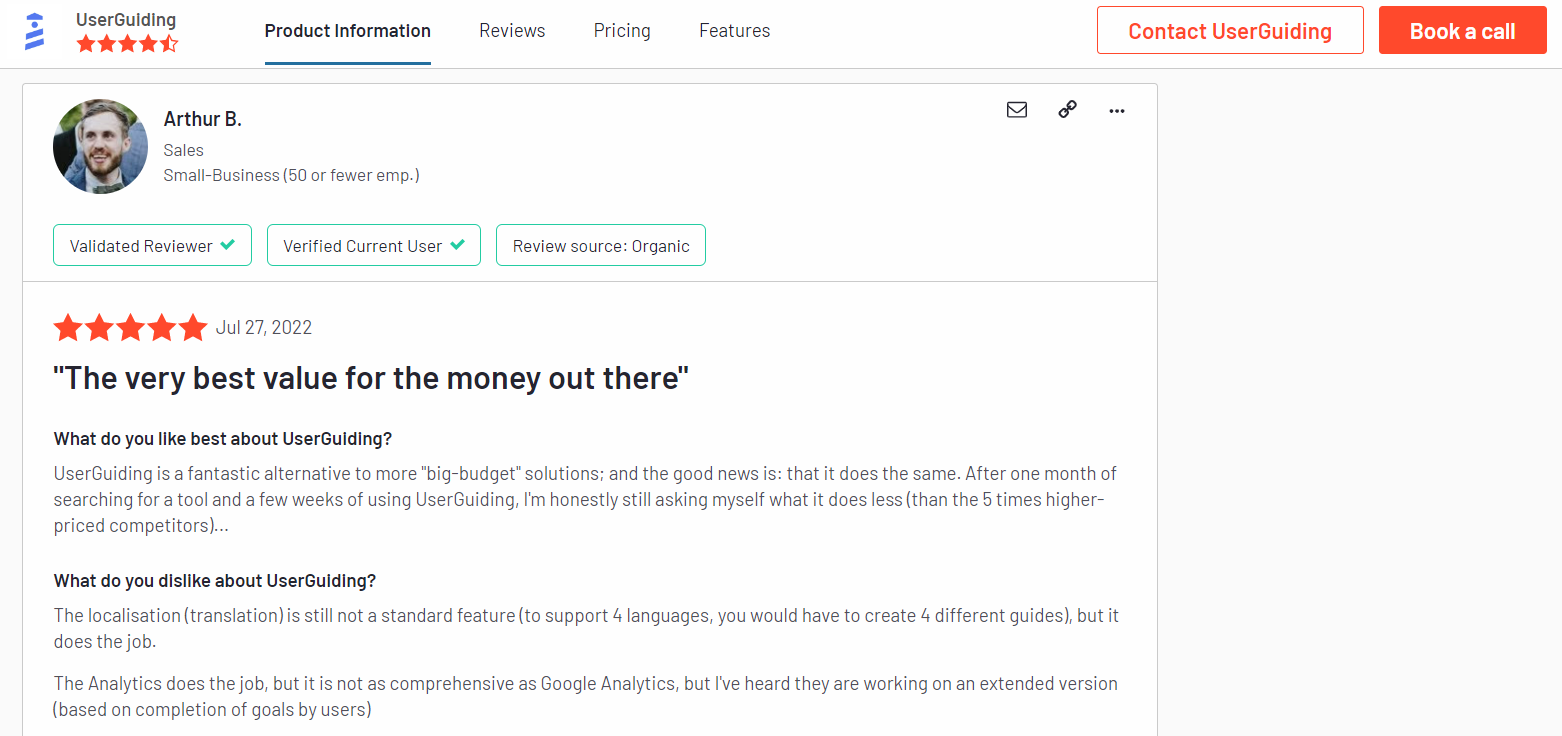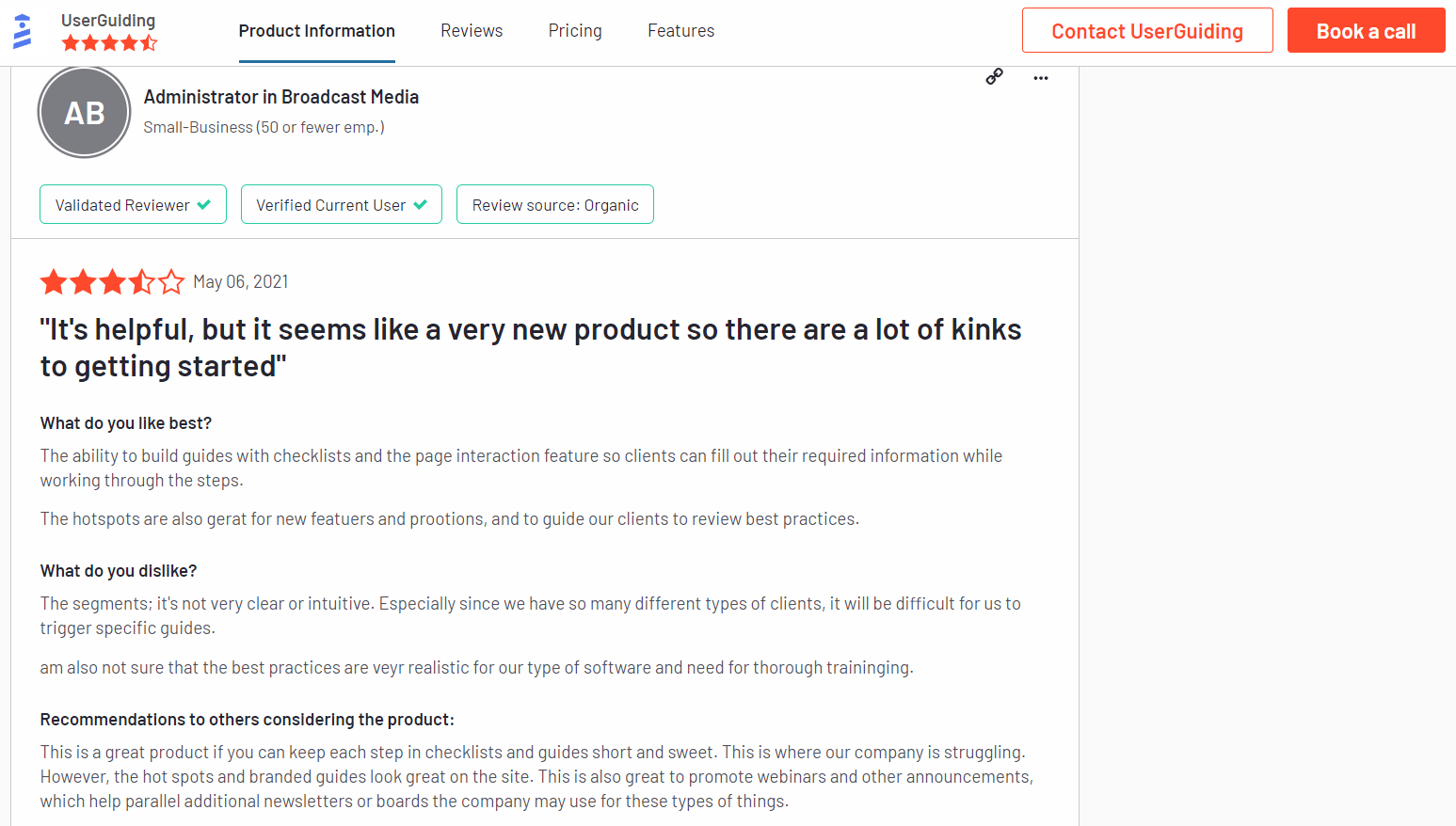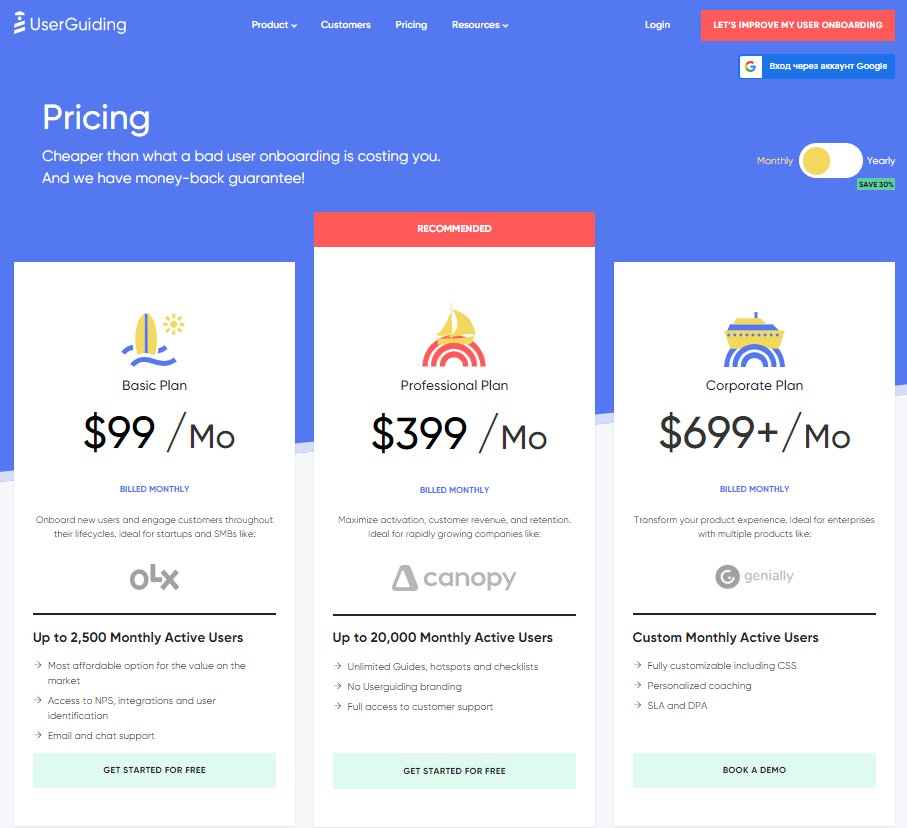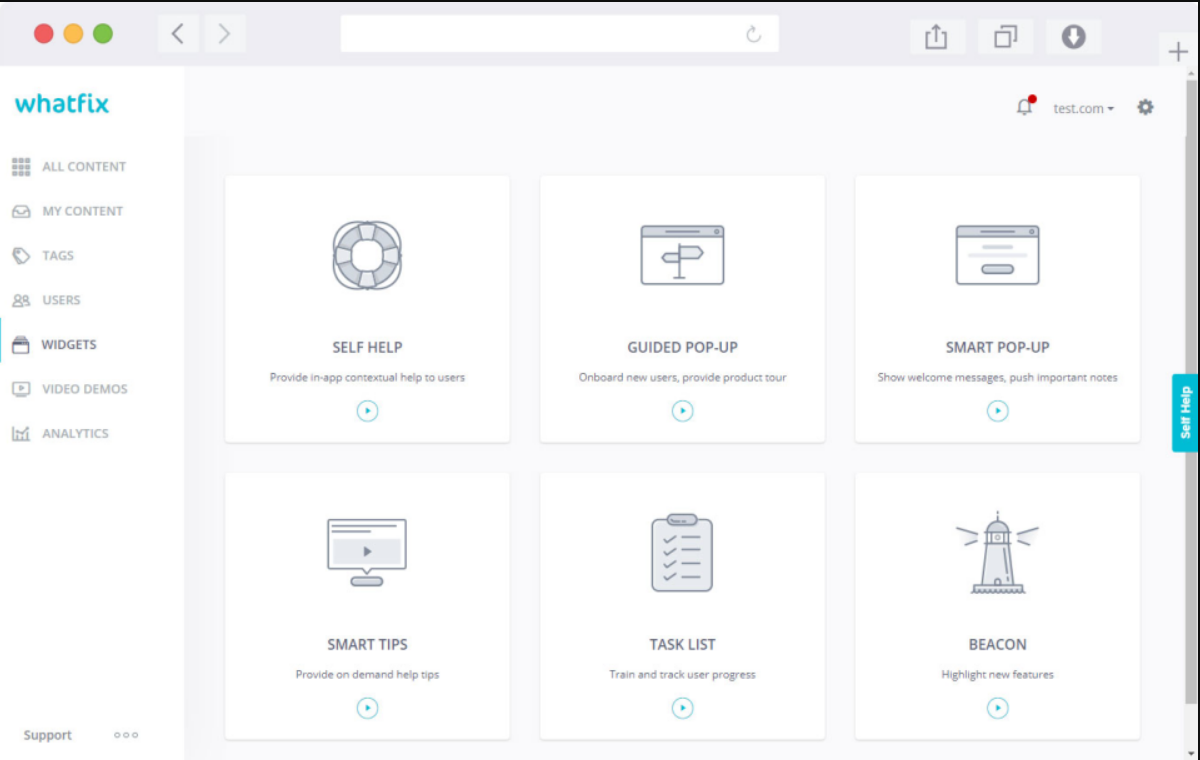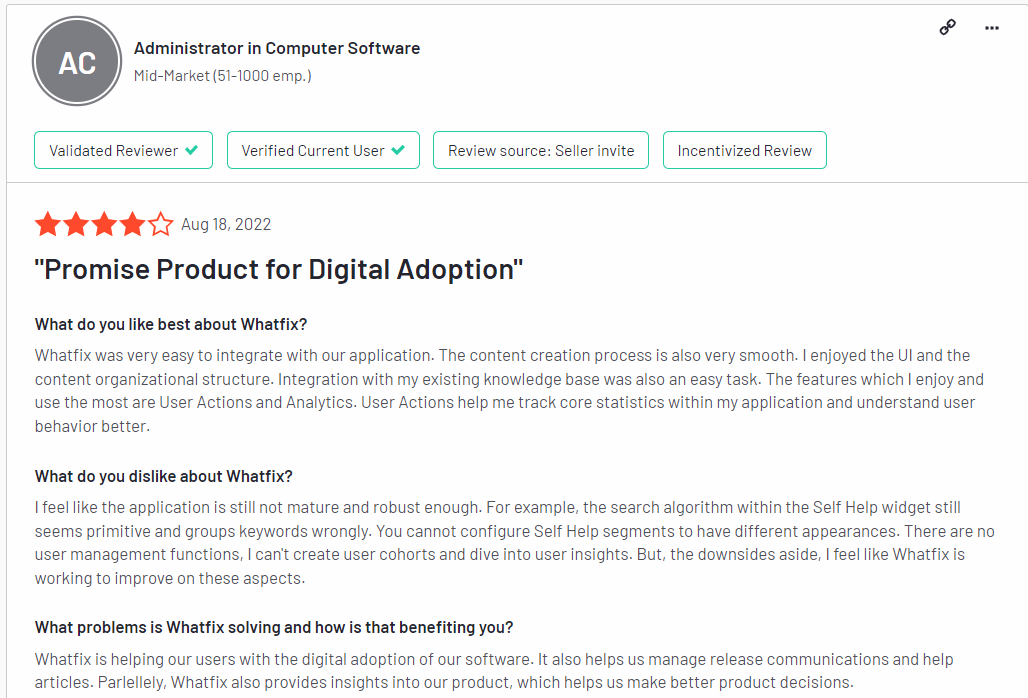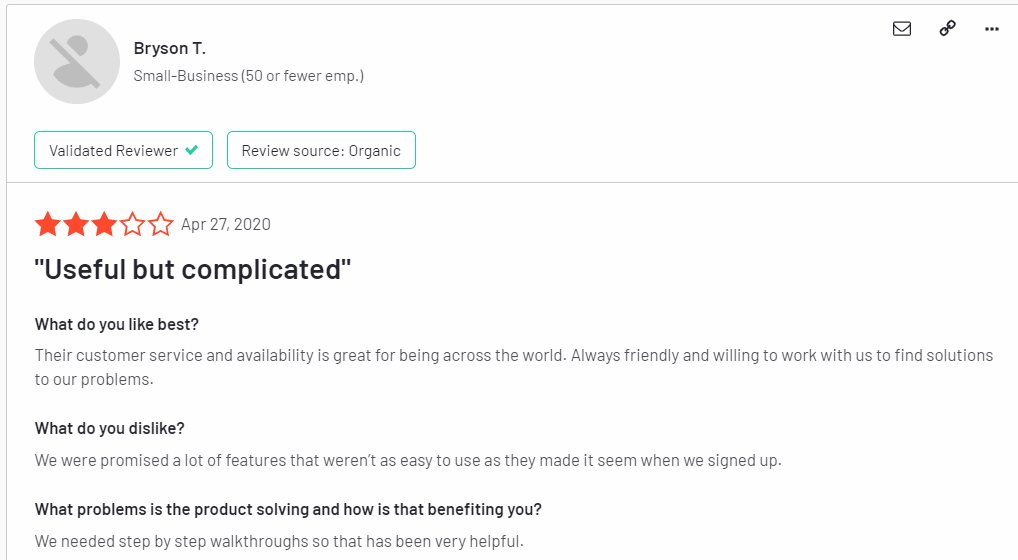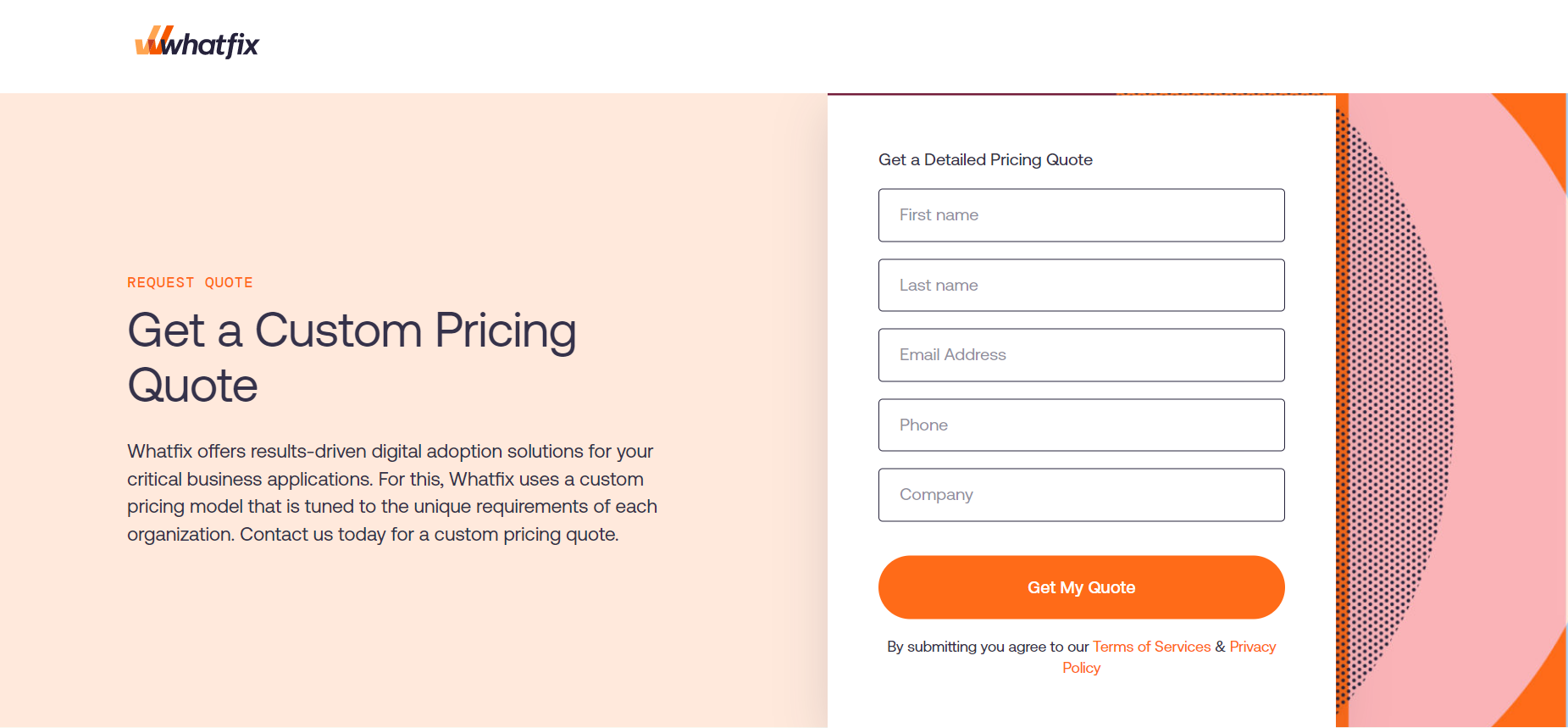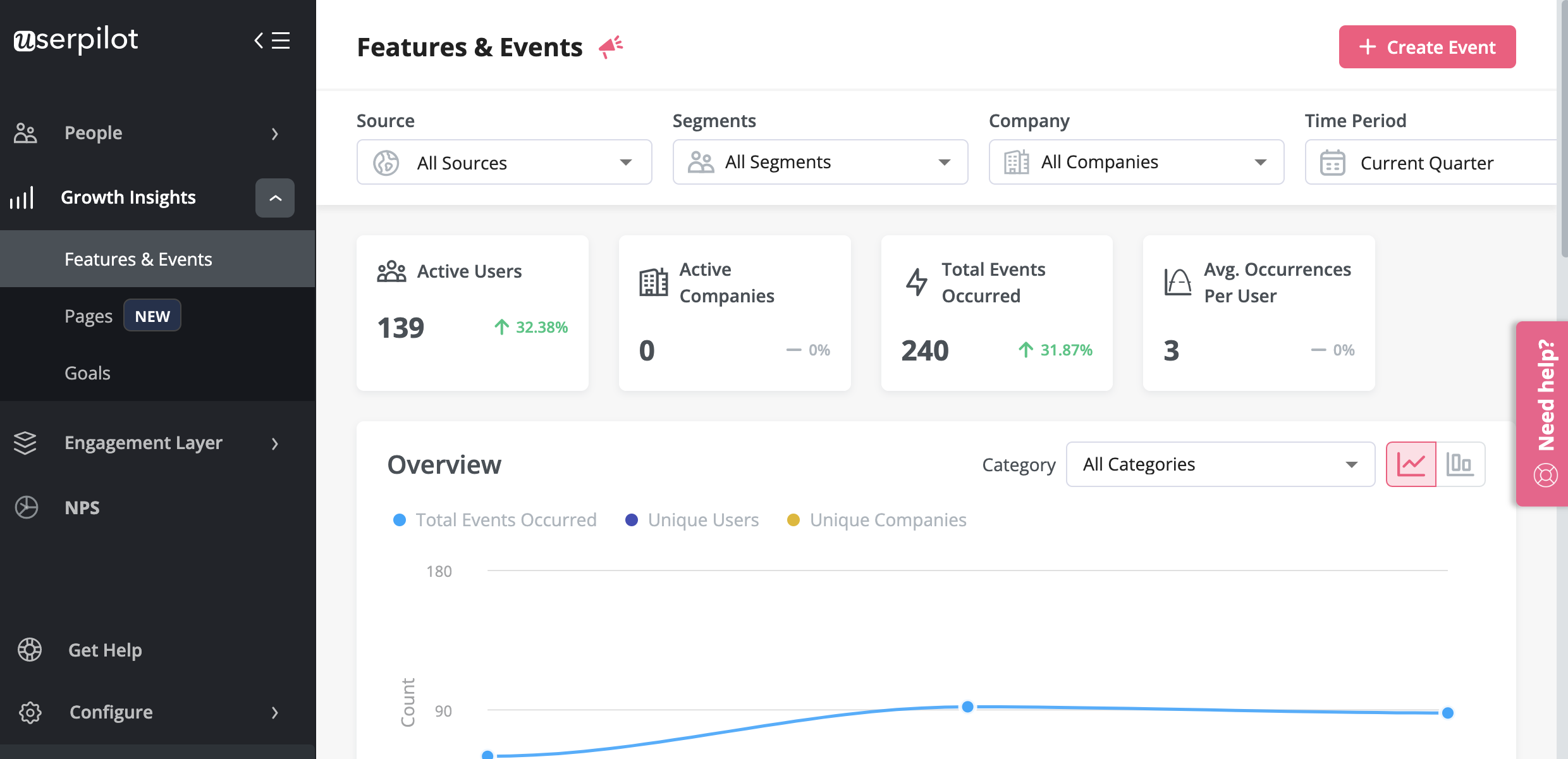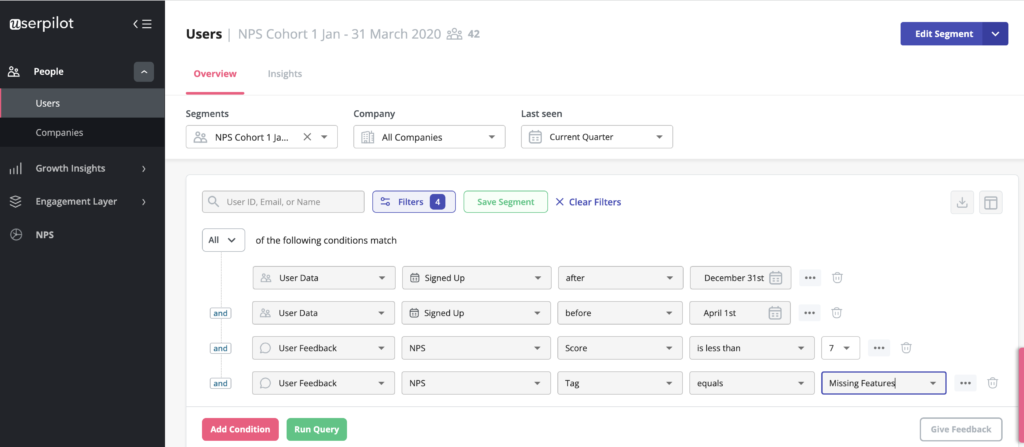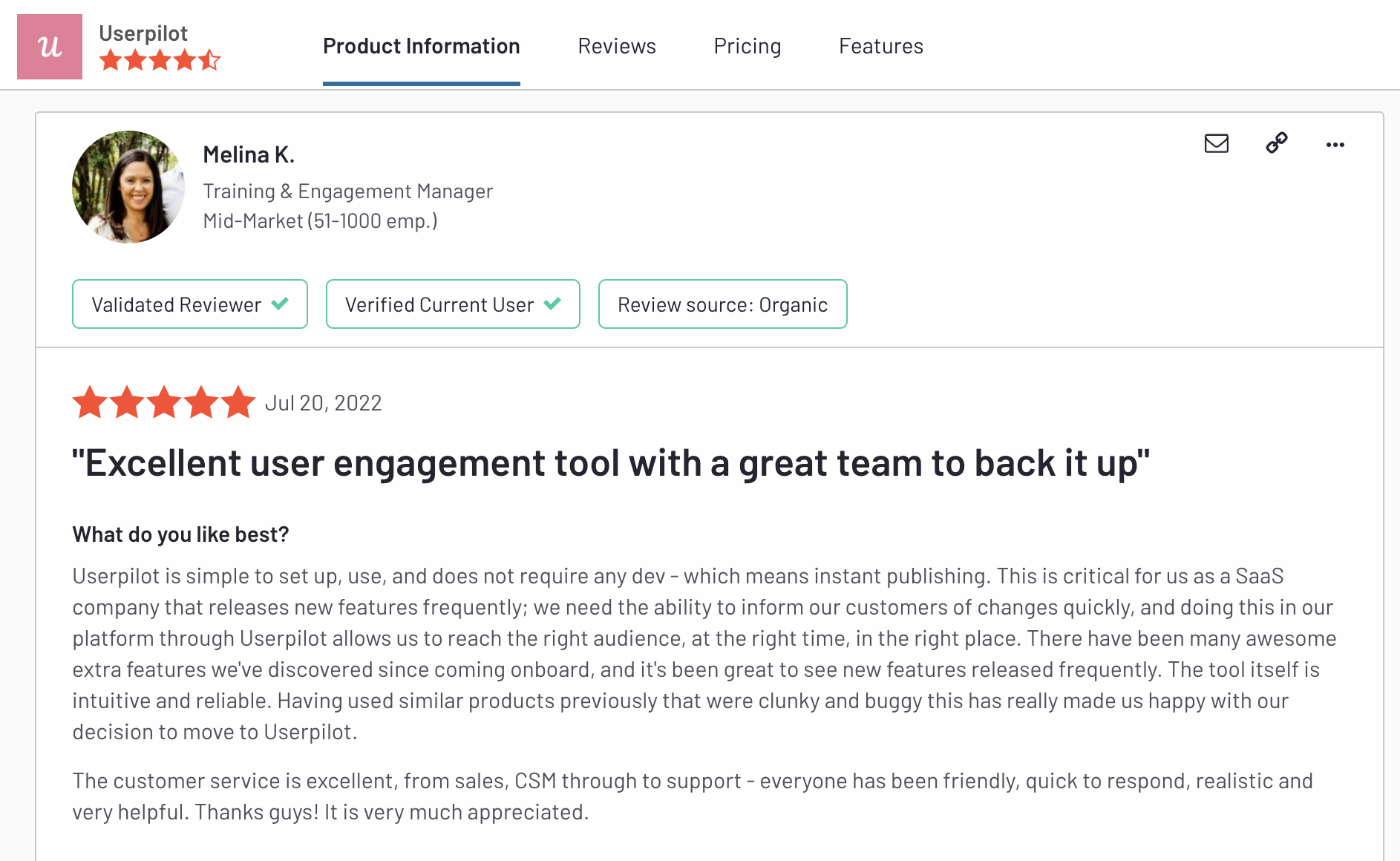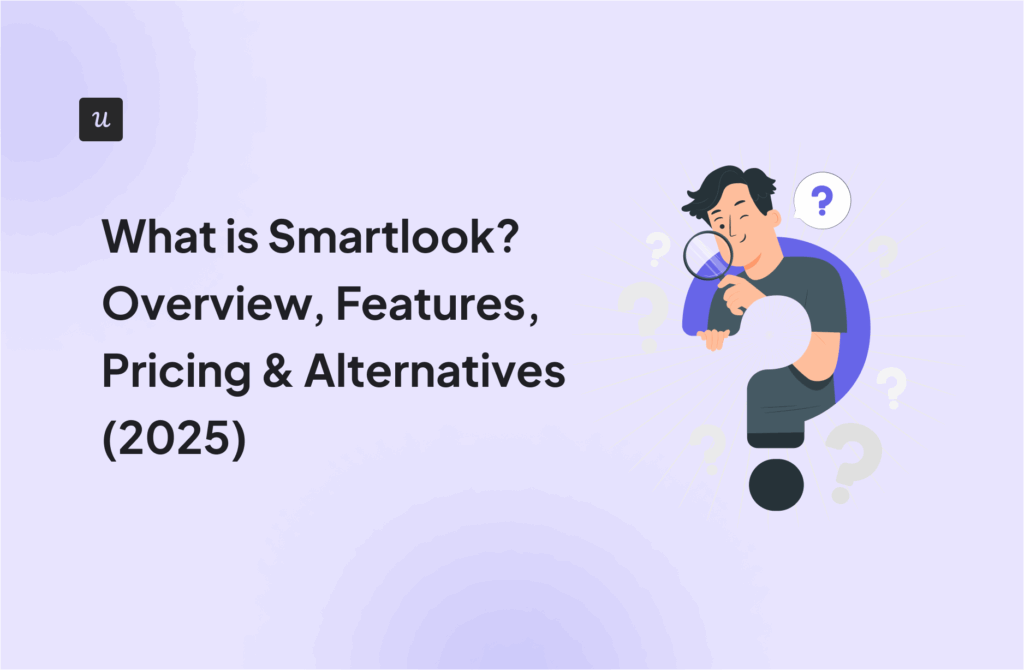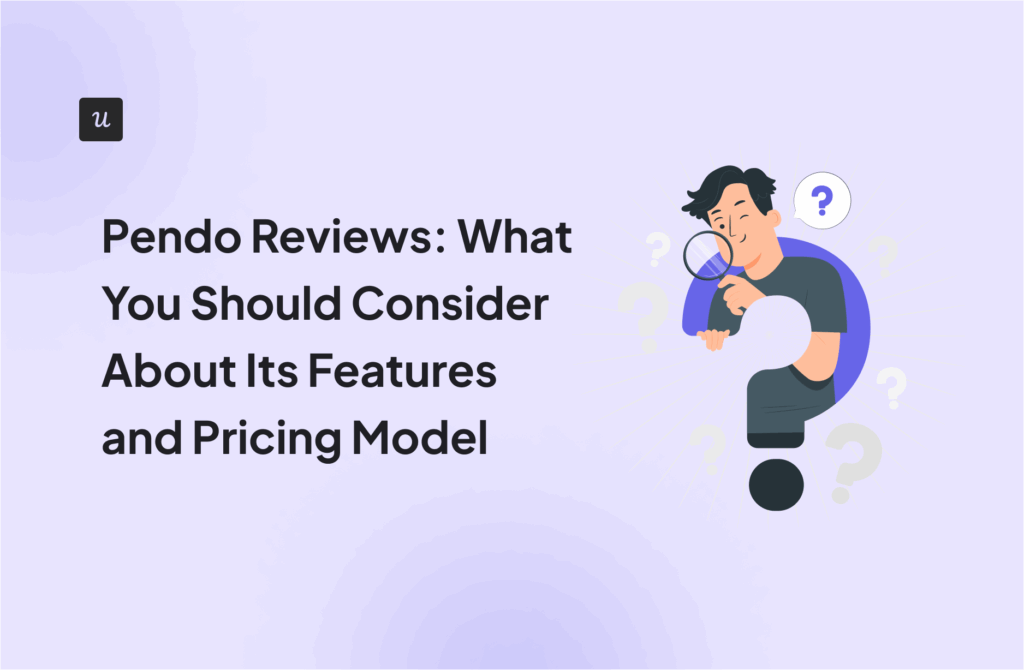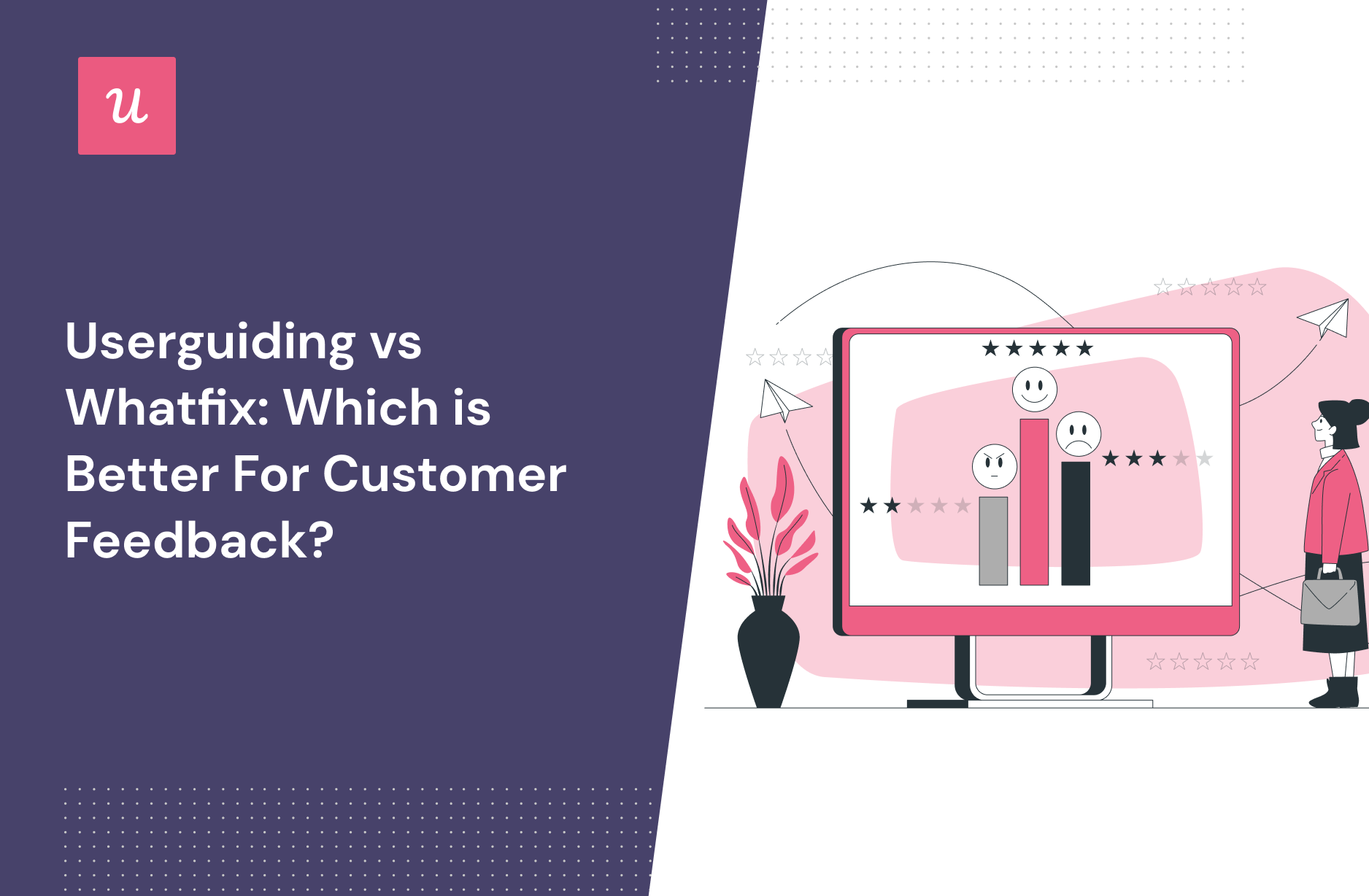
Is Userguiding or Whatfix the best tool for customer feedback? And is there an alternative in-app feedback software that delivers the best value for money?
With so many alternatives on the market, it’s a bit overwhelming to just pick one.
You need to consider your priorities and what functionality tool should have to get the job done. Then there’s also the price that needs to match your budget. Right?
In this article, we will compare the top solutions for collecting customer feedback, enabling you to make an informed decision quickly and easily.
Let’s dive in!
Try Userpilot Now
See Why 1,000+ Teams Choose Userpilot

Overview of comparison of UserGuiding vs Spekit for customer feedback
- Customer feedback is any information that customers give a company about their experience.
- Customer feedback helps you understand what is and what isn’t working in your product, then make people-centric decisions that drive product and customer success.
- Userguiding and Whatfix are digital adoption platforms that also support in-app feedback collection.
- Userguiding enables you to create and distribute NPS surveys effortlessly. The downside of using UserGuiding for collecting user feedback is that you can’t tag NPS responses so you can identify patterns between scores. You also can’t create long forms as they neither support it in their native interface nor have integrations with other 3-rd party tools to do the job.
- With Whatfix, you can create in-app surveys, collect feedback on product tours, ask follow-up questions to collect actionable insights, and send push reminders to customers so they don’t forget about providing feedback.
- As any tool, Whatfix has it’s flaws. The platform doesn’t offer in-depth customization options for surveys and lacks analytics capabilities as well.
- None of these tools have what you are looking for? Consider Userpilot, the perfect alternative for collecting and analyzing customer feedback in-app. You can use survey templates out of the box, customize them to fit your brand and UI, and trigger them contextually using segmentation. Get a Demo to see it in action.
What is customer feedback?
Customer feedback is any information provided by customers about their experience with a product or service. By analyzing customer feedback, you can reveal their level of satisfaction and pinpoint areas for improvement.
Why should you care about customer feedback?
Customer feedback is important if you want to truly serve your customers and come up with solutions that can solve their pain points.
Here is why customer feedback matters:
- Understand whether customers see value in your product and if it meets their needs
- Uncover weak spots of your product and bottlenecks that disturb the customer journey
- Make your customers voices heard and acknowledge them that they are important to you
- Collect real-time insights on the go as you’re introducing new features or product updates
Why do you need tools for customer feedback?
Wondering why you even need a customer feedback tool? There are several reasons why you may need one:
Collecting customer feedback should be a standard procedure for any product team. It should be consistent and gained across different stages of the customer journey so you can measure customer experience in different situations. This might be time-consuming but thanks to customer feedback tools, the process can be hassle-free and literally without any coding.
Here’s how customer feedback tools help.
- Create different forms of micro surveys, such as NPS, CSAT, CES, and PMF to collect contextual feedback
- Customize the surveys so they are aligned with your brand and match the interface of your app
- Segment customers by their feedback so you can create personalized flows for them
- Conduct a user sentiment analysis to understand your customers better
Now you might ask yourself, how to choose the right customer feedback tool for your SaaS? This is what we will be discussing next.
Must-have features for customer feedback tools
Before deciding which customer feedback tool works best, you should understand what features any solid tool must provide.
Here’s what to look for before making a buying decision:
- Make sure the tool you choose supports multiple forms of microsurveys. The most important and popular ones for collecting customer feedback include the Net Promoter Score, Customer satisfaction score, Customer effort score, product-market fit survey, etc
- You should also get customization capabilities so that the surveys you create match your interface and don’t look odd. No tool branding is also preferable
- Feedback analytics and response monitoring are the next key features if you want to not only collect feedback but also analyze it and understand the intent behind your customers’ scores.
- Integration with 3rd party survey and analytics tools so you can enrich your surveys to make the most out of the customer feedback
There you have it. These are the basic features you should be looking for, but the tool you should go with must be dependent on your specific goals. You might need a tool that must cover all of these features but if you don’t need complex features, you should be completely ok with a tool with limited functionalities.
Userguiding for customer feedback
UserGuiding is a lower-cost, entry-level product adoption tool offering a range of features to help companies onboard new customers and boost product adoption.
UserGuiding excels at building simple onboarding experiences for users. It includes a no-code builder, segmentation options, and easily added UI patterns like hotspots, tooltips, and modals.
Although it also has some other goodies like a resource center and analytics, the meat of this product is its onboarding flow builder. If all you’re looking for is a relatively easy way to build simple onboarding flows, this could be a great choice for you. However, people looking for more analytics, customization, or complex integrations should probably look elsewhere.
With UserGuiding, you can collect user sentiment data with NPS surveys and microsurveys even when using the Basic plan.
Here’s how you can collect user feedback with UserGuiding:
- Build NPS surveys without writing a single line of code.
- Adjust the thank you page and add a follow-up question to gather qualitative data and understand the reasons behind the scores.
- Customize the button texts, colors, and design to match your brand
- Set up custom audiences, segments, timing, and targeting rules to trigger the surveys
The downside of using UserGuiding for collecting user feedback is that you can’t tag NPS responses so you can identify trends between scores. You also can’t create long forms as they neither support it in their native interface nor have integrations with other 3-rd party tools to do the job.
Considering that, Userpilot undoubtedly offers you more value for money. You can build micro surveys, embed Typeform long surveys, collect and analyze NPS responses, and segment users based on scores and responses so you can trigger more personalized experiences. Get a Userpilot demo here!
Pros of Userguiding?
There are some advantages when it comes to choosing UserGuiding. Here are its pros:
- For small startups or independent businesses, the price is an attractive element to consider.
- A good variety of UI patterns to choose from when building flows and guides
- Unlike some of the more expensive options, you can choose to add a Resource Center (a bonus for self-service support).
- For a budget tool, UserGuiding still offers integrations with other applications, such as Mixpanel, Hubspot, Woopra, Slack, Webhook, etc.
Cons of Userguiding?
Though UserGuiding is a solid product many improvements are still needed. The cons of using UserGuiding include:
- There are many bugs and performance issues when using the tool. The UI is also fairly tricky to navigate.
- It has limited functionality, particularly on the basic plan. There you only have a small range of features available – all with the UserGuiding watermark/branding.
- Technical knowledge is required to get the maximum out of this product.
- Customization and design options for UI patterns aren’t the greatest.
What do users say about Userguiding?
If you check the product review sites, most people like using UserGuiding.
Here are some reviews from real users:
Creating guides/checklists are easy to implement. It does not take a lot of time to make adjustments when you need to make changes.
You can go live with a simple guide or checklist within minutes. I was able to go live within a few days of getting started. – Administrator in Computer Software
However, some people think there’s too much friction due to bugs. Let’s have a look at some negative reviews to see why users complain about:
It is a bit buggy, sometimes it lags or freezes.
And, some people think that there is still room for improvement:
The analytics felt a little elementary. Other than the Mixpanel integration, it wasn’t possible to analyze user data directly on the UserGuiding dashboard. There was an API we could use that required some set up, but this was something I expected to be baked into the product for sure.- Administrator in Computer Software
Is Userguiding the right fit for your business?
UserGuiding is a great fit for small SaaS businesses but it might be not the right fit if you want to:
- Create fully interactive product tours
- Build segments completely code-free as segmentation features aren’t very intuitive and may require additional help from a developer
- Get in-depth analytics. Though UserGuiding does have analytics functionality, it’s not complex and doesn’t give you much data.
Userguiding pricing
UserGuiding’s pricing model is far simpler than others on our list. There are three tiers, each one charging a set amount for access to certain tools.
Here are its packages:
- Basic will give you access to only the most essential onboarding tools: Starting at $99/mo or $69/mo (if you buy the yearly contract), this budget option has a few limitations to consider (i.e. just 1 Team Member, a limit of 20 guides, and 2 checklists, UserGuiding branding on all UI patterns).
- Professional adds unlimited guides, hotspots, and checklists. Starting at $399/mo or $299 /mo if billed yearly.
- Corporate gives you access to everything plus personalized coaching. Starting at $699/mo or $499.mo for a yearly plan.
There is a better tool for your SaaS than Userguiding!

Whatfix for customer feedback
Whatfix is one of the top digital adoption platforms around and a driver of innovation in this space.
Whatfix offers a well-made product that allows you to create user flows, knowledge bases, and task lists to get new users engaged and learning. On top of this, their analytics platform is easy to understand and helps you keep track of behavior analytics, guidance analytics, and user feedback all in one place.
If you want to collect user feedback on specific interactions, Whatfix is a good tool to build micro surveys for that
Here’s how you can collect user feedback with Whatfix:
- With user surveys, you can collect feedback on the onboarding tours and training flows, so you can continuously improve your product support.
- Whatfix’s in-app feedback surveys make it easy to gather feedback and insights from users in real-time.
- Add a follow-up question to enable open-minded feedback
- Send push reminders to customers so they don’t forget about providing feedback
However, if you want to build traditional NPS surveys with response tagging capabilities, then segment customers based on their feedback, Whatfix might not be the best fit for you. This is something that Userpilot offers.
Pros of Whatfix
There are many advantages when it comes to choosing Whatfix. Here are its pros.
- Easy to create flows, even for non-technical team members.
- Allows you to develop knowledge bases for self-help solutions.
- Ideal for both customer and employee onboarding.
Cons of Whatfix
But at the same time, Whatfix has some cons so it’s better to get an overview if you’re thinking of buying it:
- User experience issues, including bugs and sometimes spotty customer service.
- Fewer analytical features and views than you might like.
- Lacks in-depth style customizations.
- It’s difficult to integrate some of the scripted code in the admin integration sections without the help of a Whatfix support team member.
- No free trial option despite it being stated on the homepage.
- It’s targeted at enterprise accounts so small companies might get ignored.
What do users say about Whatfix?
Overall, Whatfix is a good tool and customers are happy with the product. Here is what their customers say about the product.
Our Whatfix Customer Success Manager Kritika has been amazingly responsive to our questions and creative in finding solutions.
Their team really helped us during a project we were doing, and I think they would be great for any company looking for help. This is a must to onboard customers and drive retention.
Though Whatfix is considered a solid tool in the market some people have complaints. Mostly they are related to complications for non-technical people and instability.
Here is what they say:
We were promised a lot of features that weren’t as easy to use as they made it seem when we signed up.
The tool itself is challenging for the less technical people to use the tool, as you need to know the css classes to show flows and steps.
unexpected issues and roadblocks in implementation that can cause delay or a need for an alternate approach
Is Whatfix the right fit for your business?
Though Whatfix is a good tool for user/employee onboarding and it’s used by many companies, there are still some logical reasons why you might look for an alternative:
- It’s designed for enterprise companies and the pricing reportedly starts from $1200/per month. So it’s not something you’ll be delighted to buy if on budget.
- Whatfix doesn’t support NPS surveys so you can’t collect user feedback and measure customer loyalty
- Though you can create onboarding flows, tooltips, and beacons with Whatfix, there are many cost-efficient tools in the SaaS market that provide the same or even more functionality with customization options at a much lower cost.
Whatfix pricing
Whatfix doesn’t have any pricing plans on its website. Instead, you’ll need to speak with one of their team members to get a custom quote tailored to your needs and organization.
Otherwise, you can request a free trial to see if Whatfix works for you.
There is a better tool for your SaaS than Whatfix!

Is there a better alternative for customer feedback?
Userguiding and Whatfix are good tools for customer feedback. We’ve seen how they compare to each other and what you can achieve with them. Call us biased, but if you’re looking for something better, Userpilot offers more value for your money than these tools.
Userpilot for customer feedback
Userpilot is a powerful product adoption platform that enables you to quickly build personalized, flexible, contextually relevant in-app experiences targeted to different user segments – all without writing a line of code.
There are two types of feedback you should be focusing on collecting to better understand the health of your product and users.
First, you have user sentiment which looks at user satisfaction and effort scores or loyalty (using NPS surveys). Then you may also want to collect feedback on the functionality of the product or specific features.
You can do all these with Userpilot. In short, you can:
- Collect and track (NPS) in-app with a built-in NPS widget that allows you to fully customize the survey look and feel, and set the trigger frequency and specific targeting.
- Analyze NPS scores, tag responses, and use the data to create specific user segments.
- Build and trigger in-app micro surveys like the classic PMF survey, or similar ones and mix multi-choice and open-ended types of questions to collect specific insights.
- Be in charge of who gets which survey type and when with advanced segmentation capabilities, and of course, you can use the answers to segment your audience.
The advantage of using Userpilot for collecting feedback over other survey tools is that you can better control who sees the surveys but also you can instantly use the data collected to segment your user base and trigger the right experience for them.
For instance, if your users give you a low NPS score because they think you’re missing a critical feature (that you actually have already), you can push an interactive walkthrough guiding them to find and explore this feature.
Pros of Userpilot
Userpilot has a number of advantages, especially for mid-market SaaS companies looking for a robust but at the same time very easy-to-use, no-code tool for user onboarding, product adoption, and simplified product analytics. Let’s have a look at the pros of using Userpilot:
- No-code builder – Userpilot comes with an easy-to-use Chrome Extension builder.
- Multiple UI patterns – choose from a range of options to build customized flows: modals, slideouts, banners, tooltips, hotspots, and checklists are all at your disposal
- UI patterns are not limited by plan – you get access to all of them on every single plan, meaning you get value even with the Traction plan (this is the entry-level one).
- Engaging walkthroughs and onboarding flows- build interactive walkthroughs targeted to distinct user segments.
- In-app help – build a resource center offering self-service support to your users, customize it with your branding, and select from a range of help options to boost user satisfaction (i.e. videos, in-app flows, chat, and more).
- Experimentation – built-in A/B testing for flows lets you explore and quickly iterate based on direct user behavior.
- Powerful feedback options- integrated NPS surveys with analytics and response tagging unlock insight into how your users feel.
- Advanced analytics and segmentation- analyze product usage and in-app flow engagement and build user segments using the data.
- Event tracking and feature tags- tag UI engagement (clicks, form fills, hovers) and group them into one custom event to track what really matters.
- More value with integrations- unlock value faster with built-in integrations with popular tools like Segment, Amplitude, Mixpanel, Kissmetrics, Intercom, Heap, and more.
Cons of Userpilot
Userpilot has a number of advantages, especially for mid-market SaaS companies looking for a robust but at the same time very easy-to-use, no-code tool for user onboarding, product adoption, and simplified product analytics. Let’s have a look at the pros of using Userpilot:
- No-code builder – Userpilot comes with an easy-to-use Chrome Extension builder.
- Multiple UI patterns – choose from a range of options to build customized flows: modals, slideouts, banners, tooltips, hotspots, and checklists are all at your disposal
- UI patterns are not limited by plan – you get access to all of them on every single plan, meaning you get value even with the Traction plan (this is the entry-level one).
- Engaging walkthroughs and onboarding flows- build interactive walkthroughs targeted to distinct user segments.
- In-app help – build a resource center offering self-service support to your users, customize it with your branding, and select from a range of help options to boost user satisfaction (i.e. videos, in-app flows, chat, and more).
- Experimentation – built-in A/B testing for flows lets you explore and quickly iterate based on direct user behavior.
- Powerful feedback options- integrated NPS surveys with analytics and response tagging unlock insight into how your users feel.
- Advanced analytics and segmentation- analyze product usage and in-app flow engagement and build user segments using the data.
- Event tracking and feature tags- tag UI engagement (clicks, form fills, hovers) and group them into one custom event to track what really matters.
- More value with integrations- unlock value faster with built-in integrations with popular tools like Segment, Amplitude, Mixpanel, Kissmetrics, Intercom, Heap, and more.
What users say about Userpilot
Let’s check what real users like about Userpilot.
Userpilot is an incredible, user-friendly software that allows us to create unforgettable experiences for our clients! From basic to complex experiences, we have been able to do them all with ease! I would highly recommend this software to anyone who wants to provide their clients or users with the best product tour experience. The possibilities of what you can create are endless! – Tayla G.
Userpilot is simple to set up, use, and does not require any dev – which means instant publishing. This is critical for us as a SaaS company that releases new features frequently; we need the ability to inform our customers of changes quickly, and doing this in our platform through Userpilot allows us to reach the right audience, at the right time, in the right place. There have been many awesome extra features we’ve discovered since coming on board, and it’s been great to see new features released frequently. The tool itself is intuitive and reliable. Having used similar products previously that were clunky and buggy this has really made us happy with our decision to move to Userpilot. – Melina K.
Get more value for your money with Userpilot!

Userpilot pricing
Userpilot offers flexible pricing based on your monthly active users (MAUs). Plans start at $299 per month for smaller teams and scale as your user base grows.
Below are the pricing tiers you can choose from:
- The Starter plan begins at $299/month (billed annually) for up to 2,000 monthly active users. It includes in-app user engagement, usage trend analysis, NPS surveys, and essential product analytics—ideal for mid-market SaaS teams getting started.
- The Growth plan offers custom pricing and adds advanced analytics, retroactive event auto-capture, in-app surveys, session replay, and more. It’s the most popular choice for growing teams that need deeper insights and scale.
- The Enterprise plan offers custom pricing and includes everything in Growth, plus bulk data handling, custom roles and permissions, SOC 2 Type 2 compliance, and enterprise-level support.

Conclusion
There you have it.
It should be easier now to make an informed decision between Userguiding and Whatfix. Both tools come with advantages and disadvantages so there isn’t one that is the best. It will depend on your product and current needs. If you want the best value for money, going with the alternative option would be our recommendation. Want to see how Userpilot can help with customer feedback? Book a demo below.
Try the best tool for customer feedback!


